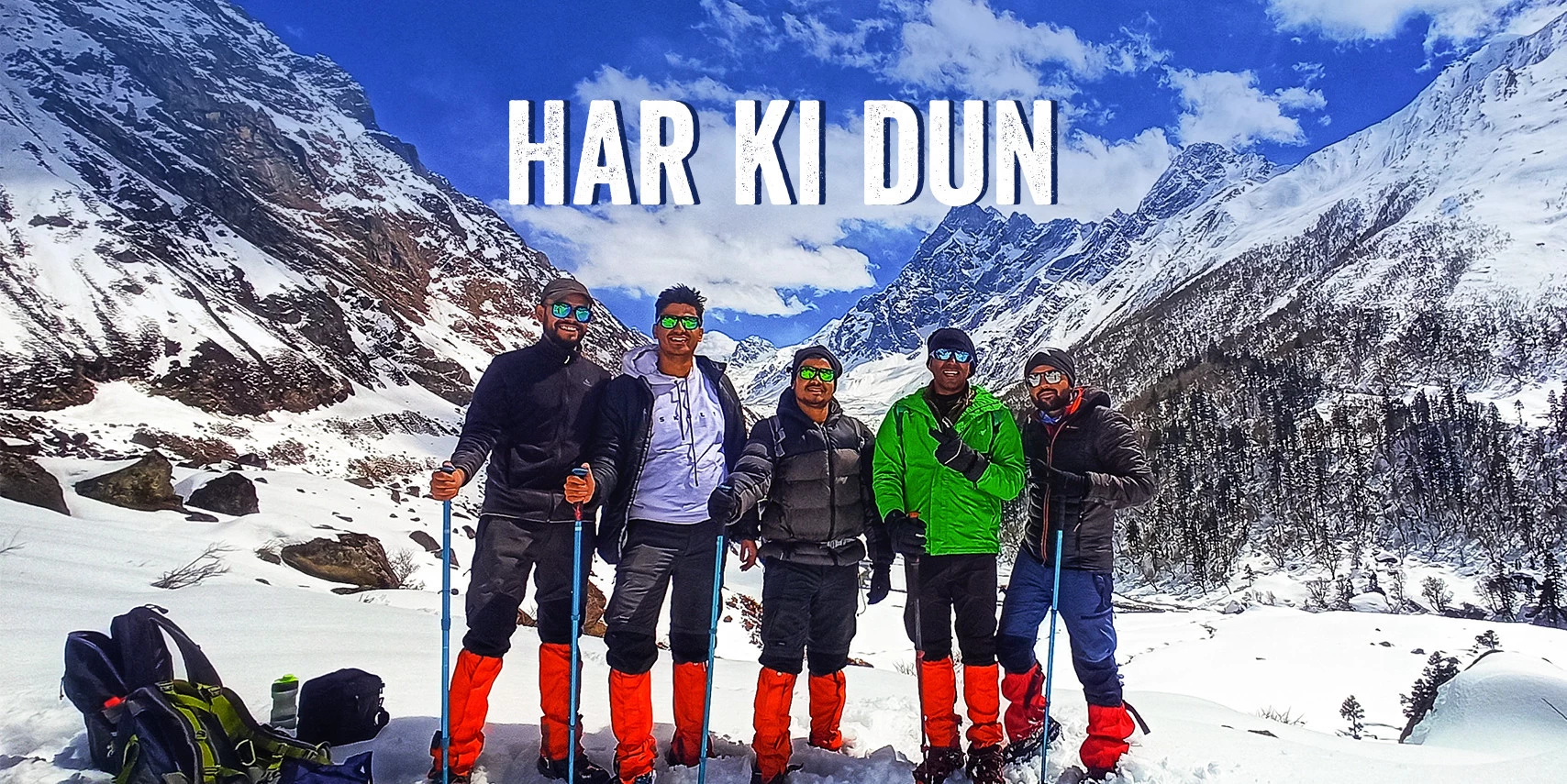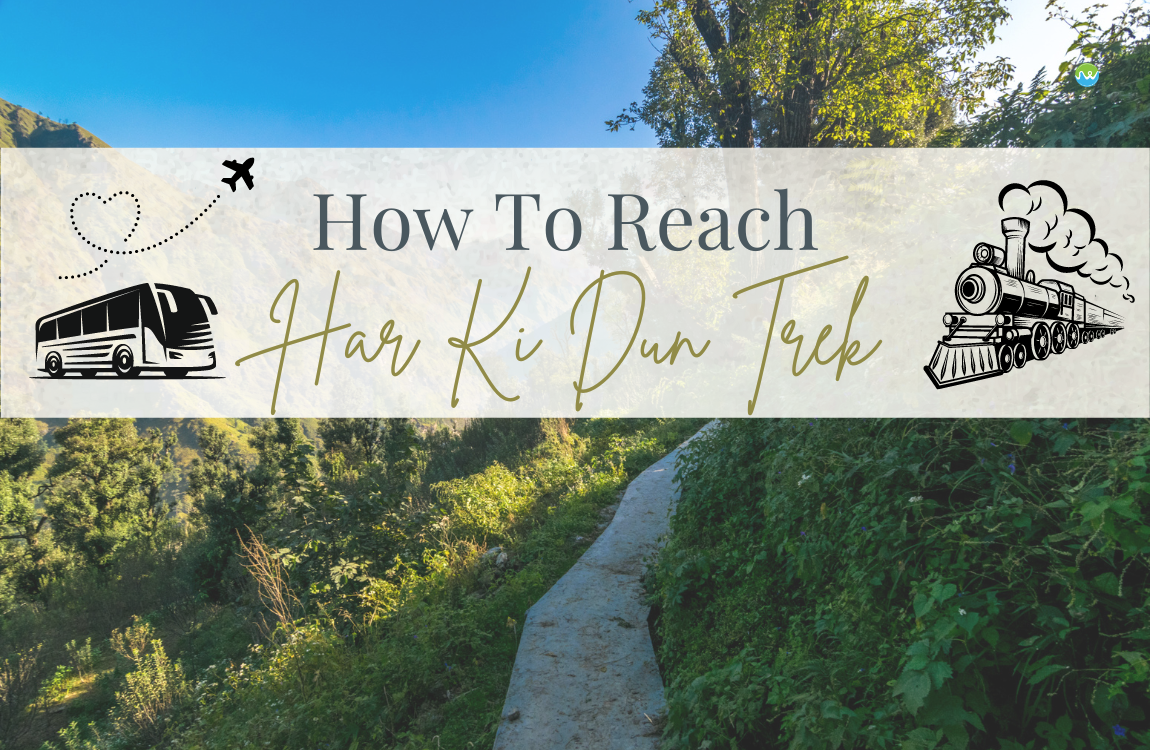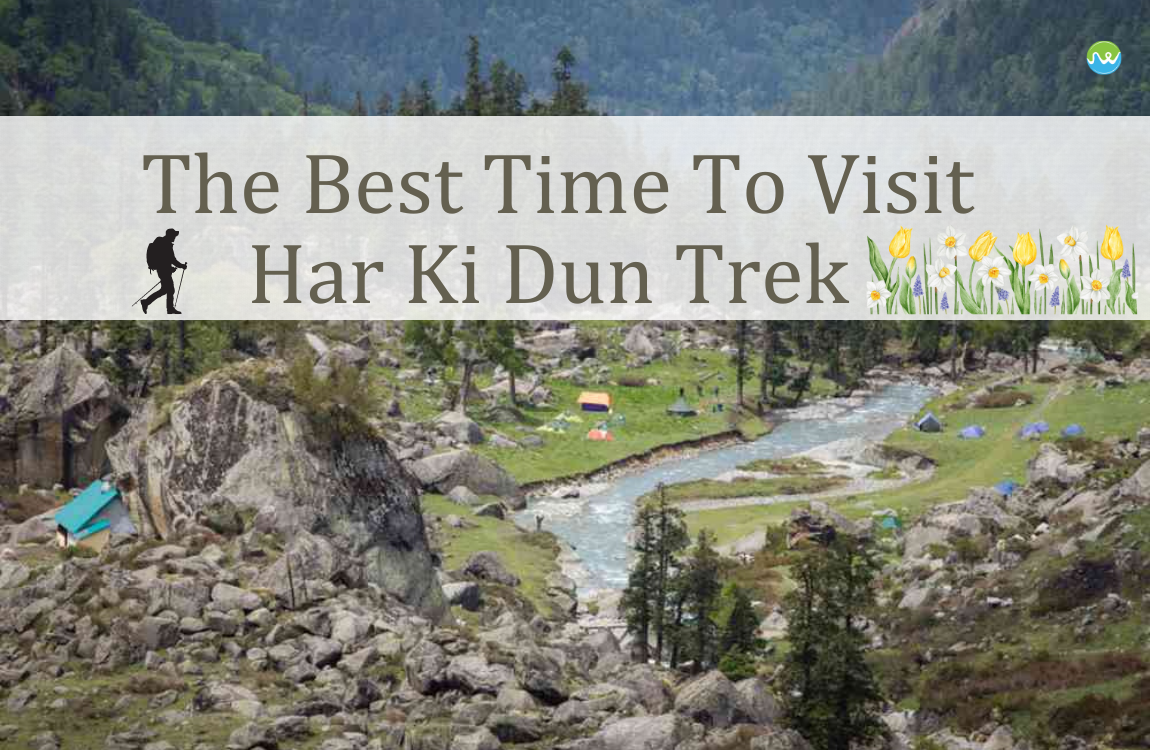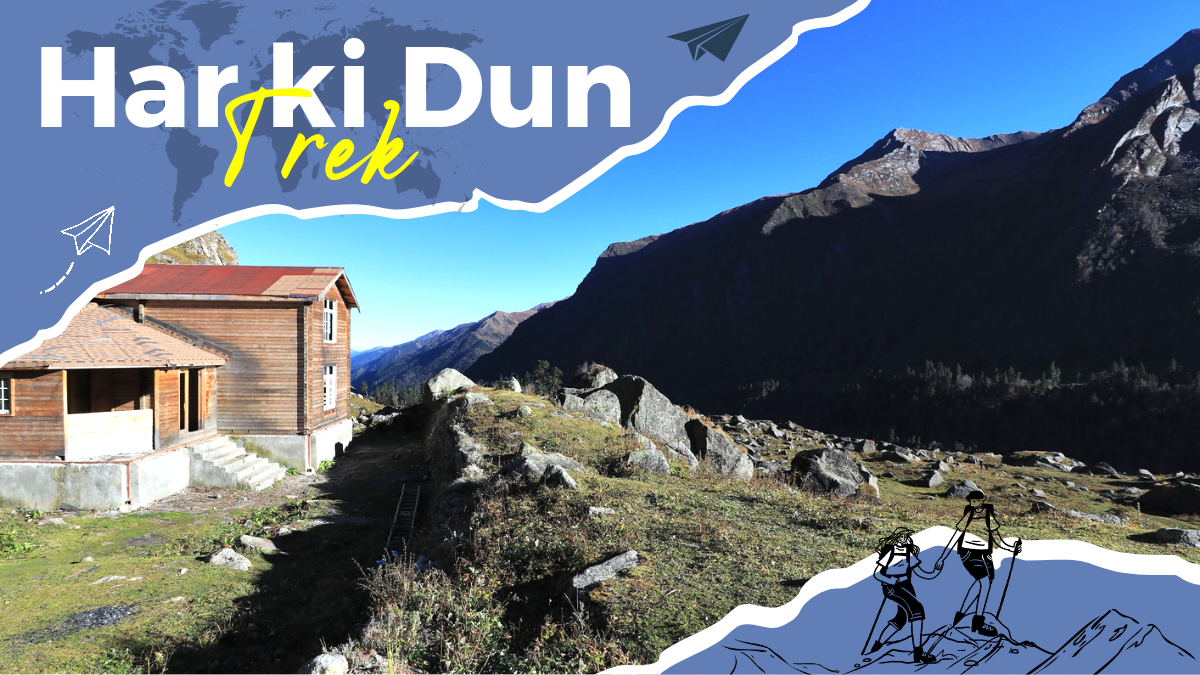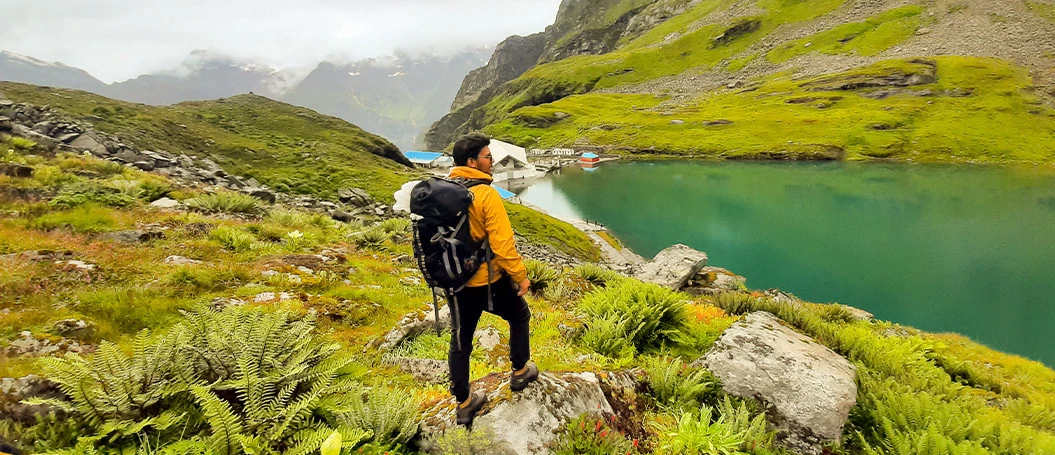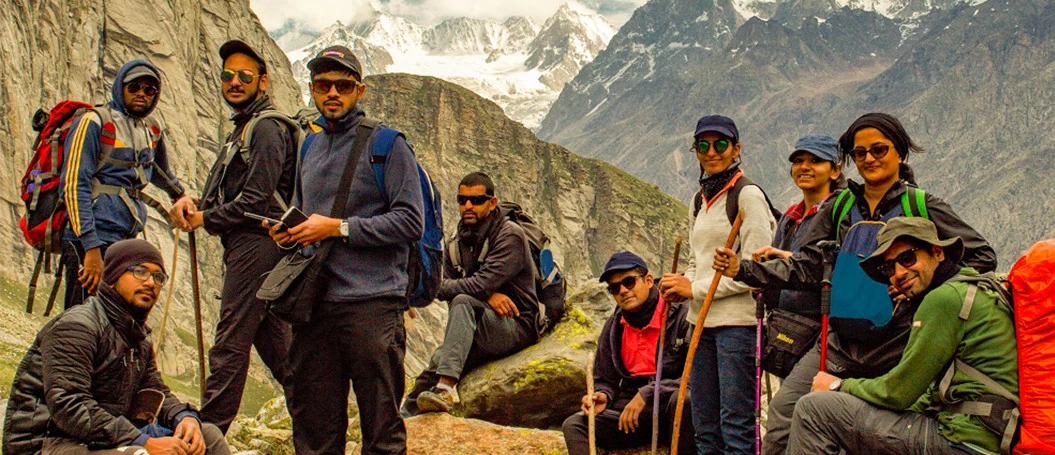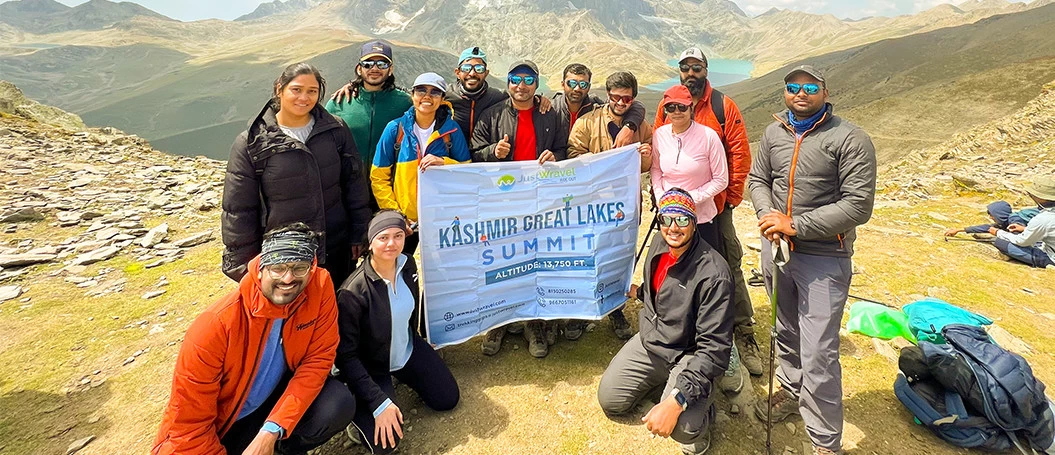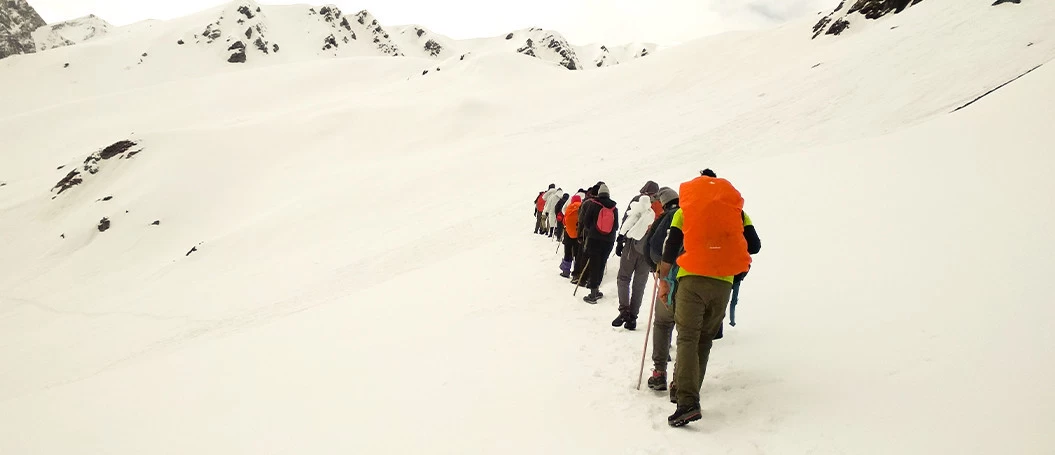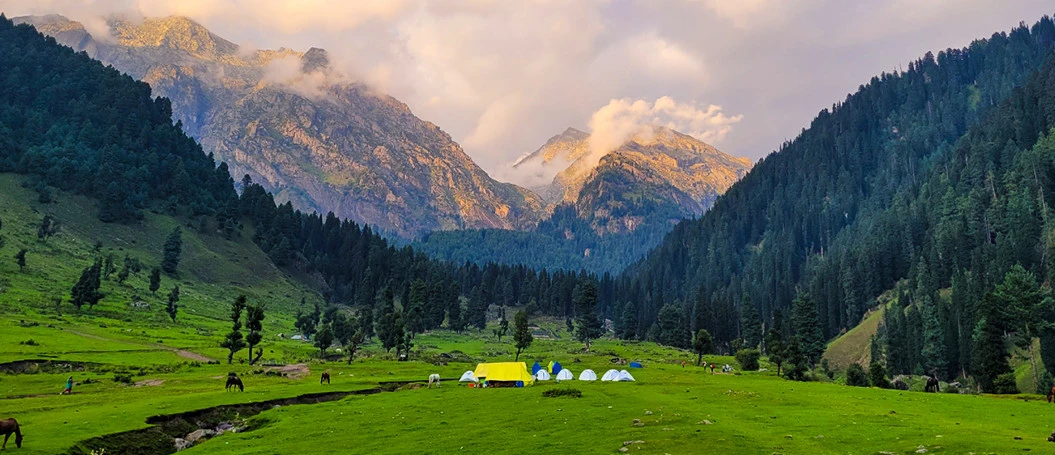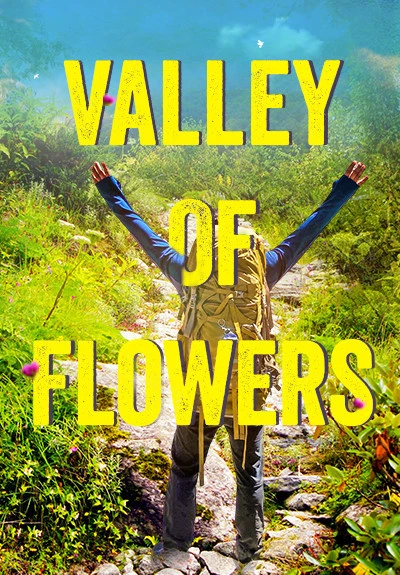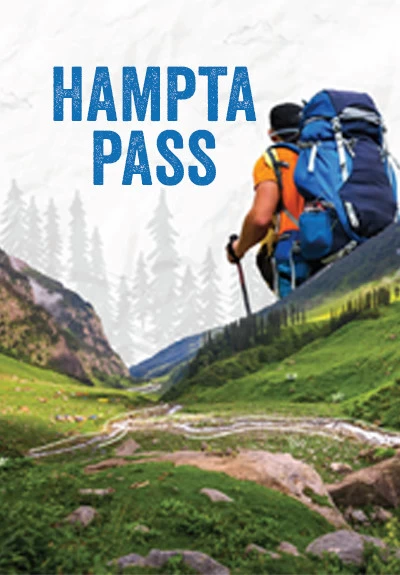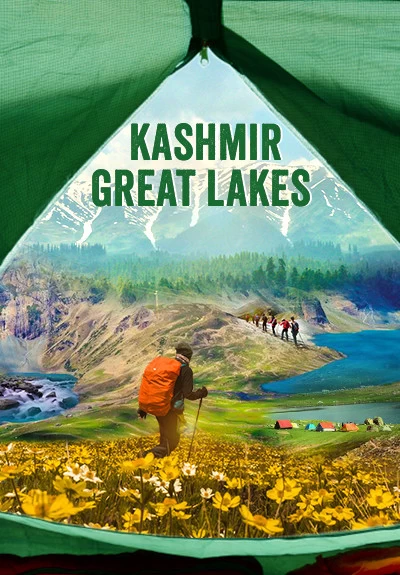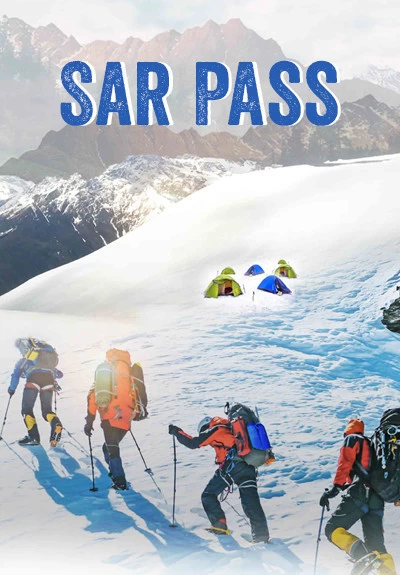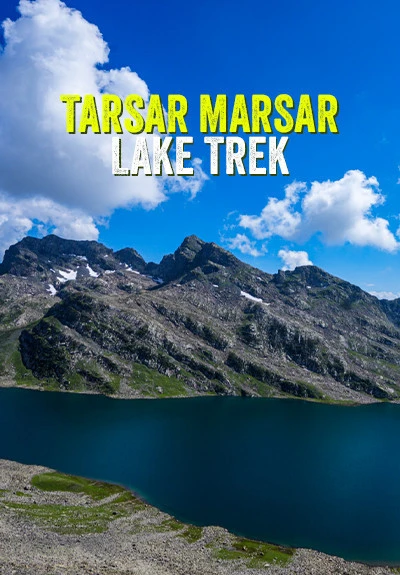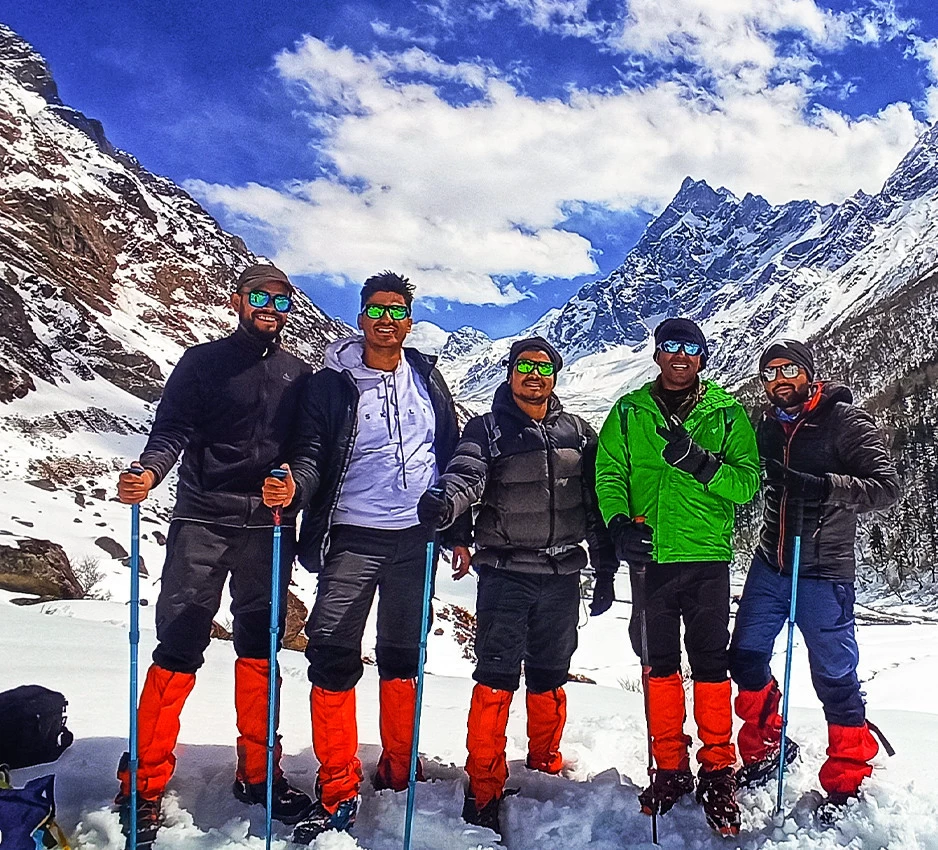
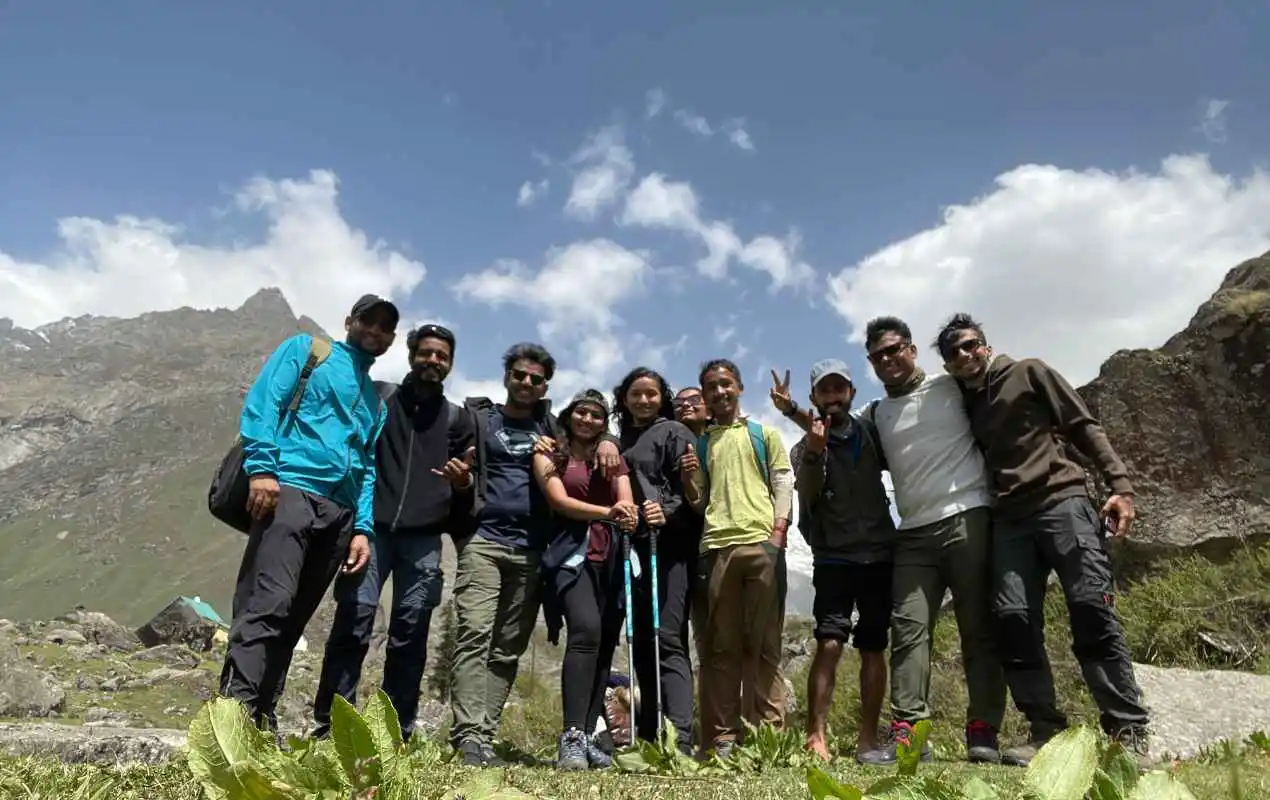
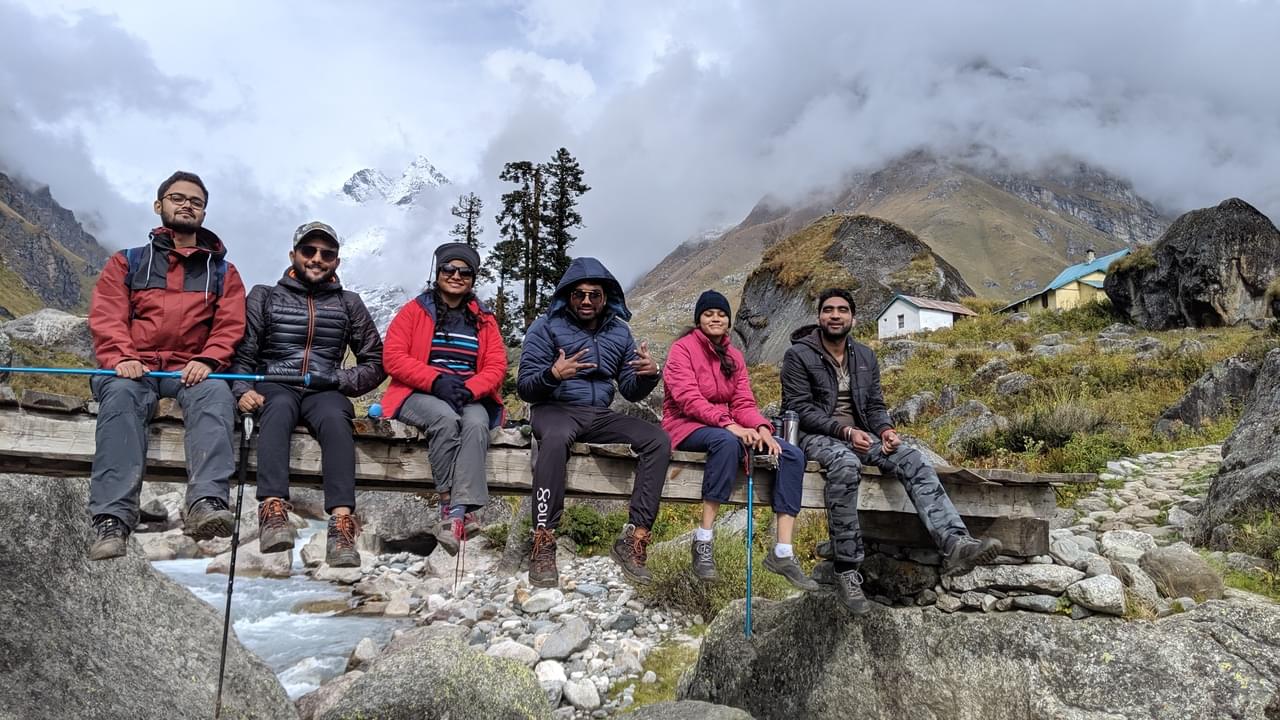

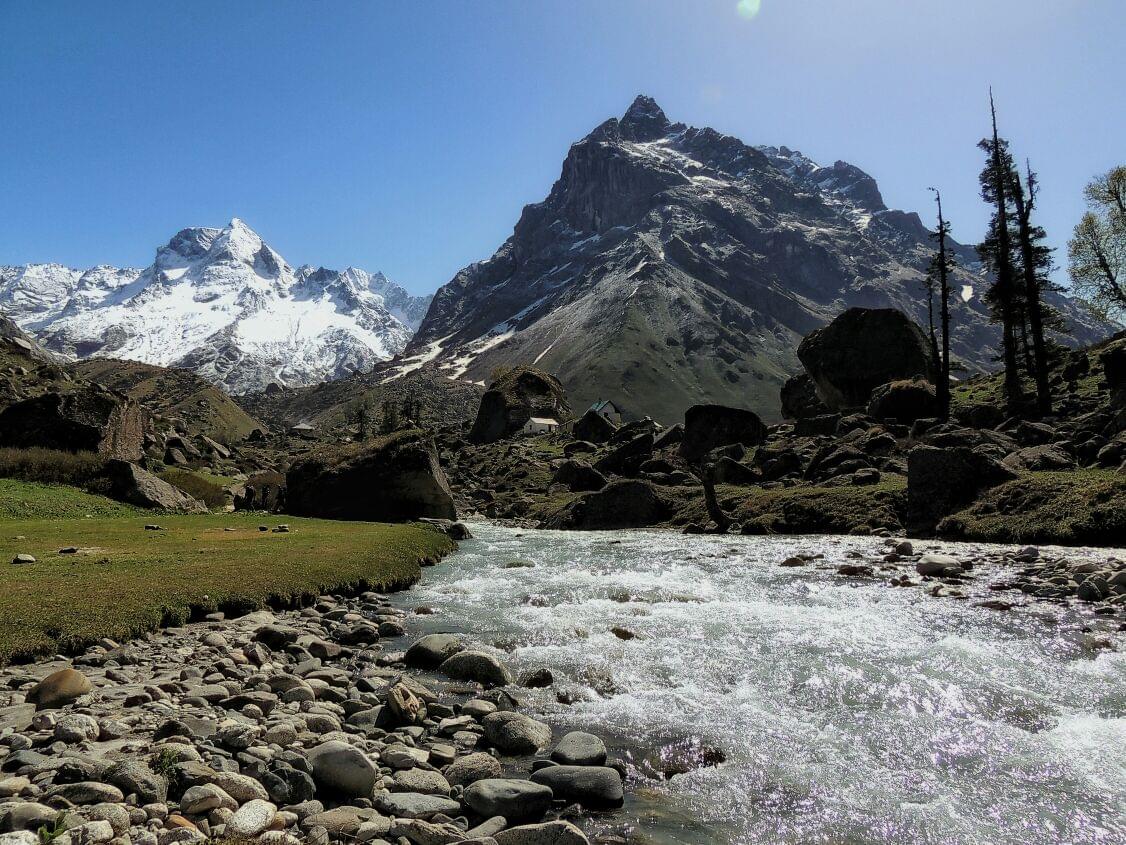
Har Ki Dun Trek
Details
Inclusions
Safe Travel
Flexible Cancellation
Easy EMI
Certified Captains
24/7 Support
Overview
At an altitude of 11,700ft, the Har ki Dun trek is in all senses, a gateway to heaven. A snow-specked paradise for winter fanatics on one hand and adorned by alpine meadows, and pine forests for all those who seek solace in the embrace of nature on the other, it is a paradise for trekkers, be it beginners or experienced ones. Nestled on the western edge of Garhwal in Uttarkashi district, the Har ki Dun trek isn't just a trek consisting of picturesque views but also has rich cultural and mythological significance. Many locals believe that the land belongs to none other than Duryodhana from the epic Mahabharata. The legend goes that a clan devoted to the Kauravas lived close to the village of Seema and built a temple to pay their respects to him. That temple exists even today. On the other hand, this trek is one of the oldest Himalayan trekking trails. The name Har ki Dun translates to “Valley of Gods” signifying its other spiritual significance regarding the myth. It is believed that this was the route that was taken by the Pandavas on their ascend to heaven, which is why it earns its name as the stairway to heaven trek.
It also provides a major source for the Yamuna River System. The diverse flora and fauna that you get to spend time listening to is a magical experience in itself and camping by the flowing riverside, listening to the relentless streams of water gives you the kind of peace that makes you forget all about the hustling and bustling noises of metropolitan cities. The people, places, and the whole trail capture an insight into a different world as compared to what we’ve seen in our daily lives.
The trek provides a spectacular view of Swargrohini peaks, Bandarpoonch, as well as Black peak. The trail leads you to villages that have been here since 2000 years ago and meeting the locals gives you a glimpse into their lives. A perfect spot for nature lovers, adventure enthusiasts as well as people who love to indulge in photography from time to time, the Har ki Dun trek is truly a blessing. Some of the best attractions of the Har ki Dun trek are the above-mentioned temple in the village of Osla, a 5000-year-old structure carved out from wood.
Har ki Dun trek is suitable for any beginner and proves to be exciting for even an experienced trekker. The Har ki Dun trek difficulty is rated from easy to moderate and provides a good overall experience. The best time to visit Har ki Dun is during the summer and post-monsoon season. The Har ki Dun valley is famous for its orchids and especially rhododendrons, which are specially grown in this region. The flora and fauna mixed with rich culture and immense historical importance secure its position among top contenders in the list of best treks in Uttarakhand. Trek to Har ki Dun takes a total of 7 days and starts from a small village named Sankri situated in the Uttarkashi district of Uttarakhand.
Gallery




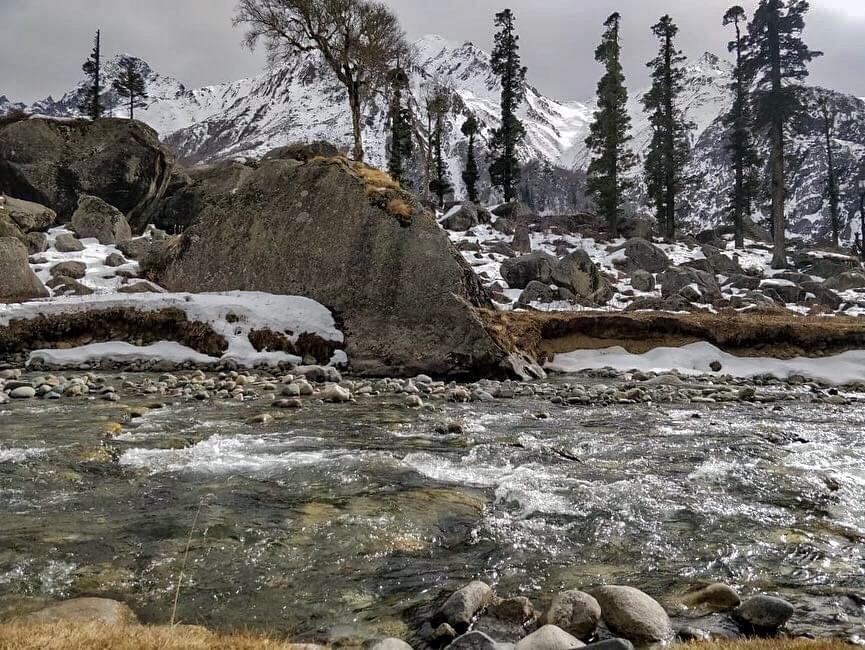
Itinerary
1
Day
Drive From Dehradun To Sankri Base Village (198 Kms, 8 Hrs Drive)
2
Day
Sankri to Gangad (12 Kms, 1.5 Hrs Drive) and Trek to Devsu Bugyal (8 Kms, 4 Hrs Trek)
3
Day
Devsu Bugyal to Boslo (8 Kms Trek)
4
Day
Boslo - Har Ki Dun - Boslo (12 Kms Trek)
5
Day
Boslo to Seema (10 Kms Trek)
6
Day
Seema to Gangad - Sankri (6 Kms Trek and 1.5 Hrs Drive)
7
Day
Drive from Sankri to Dehradun (200 Kms, 8 Hrs Drive)
Age Limit (Trip Wise)
Weekend
Getaways
18-38
Himalayan
Treks
18-48
Backpacking
Trips
18-40
Biking
Trips
18-45
Customized
Trips
No Limit
Inclusions & Exclusions
| Inclusions | Exclusions |
Accommodation: 2 Nights in a Homestay in Sankri on a double / triple-sharing basis (with attached washroom and Geyser facility) and 4 Nights Tented Accommodation on a double / triple sharing basis as per booking. Transportation: Surface transfer from Dehradun - Sankri - Dehradun by Sumo / Bolero / Tempo Traveler (Depending on the number of travelers). Meals: All veg meals from Day 1st Dinner to Day 7th Day Breakfast. Snacks: Morning / Evening Tea / Coffee with light snacks and soup while on the trek. Camping logistics: Trekking tent, Sleeping bags, Mattresses, Dining tent, Kitchen tent and Toilet tent. Trek Leader: Qualified and Experienced Trek leader and support staff. Permits: All necessary fees and permits.(For Indians) Trekking Equipment: Gaiters, Micro Spikes, and Rope if required. Safety Equipment: Walkie / Talkie , Basic First Aid kit with Oximeter, Blood Pressure Monitor and Oxygen Cylinder. Guide ratio: Local experience guide ( depends on the group size). Others : Cloak Room facility available at base camp for extra luggage. | Any expenses of personal nature. Meals during transit. Any insurance of any kind. Any fees and permits (for non-Indians). Unscheduled delay due to landslide. Cost Escalation due to “ Force Majeure and Evacuation charges”. Anything not mentioned explicitly in the above program. Bag offloading cost is Rs 1500 (maximum weight should not be more than 10 kg) |
Cancellation Policy
| Upto 21 days | 20-15 days | 14-8 days | 7-0 days | |
| Batch Shifting | ||||
| Cancellation Charge | Free Cancellation | 25% of the Trip Amount | 50% of the Trip Amount | 100% of the Trip Amount |
| Booking Amount | Refunded in mode of Credit Note | Adjusted in Refund Deduction | Adjusted in Refund Deduction | No Refund |
| Remaining Amount | Full Refund (minus) booking amount | Refund (minus) 25% of the trip amount | Refund (minus) 50% of the trip amount | No Refund |
Payment Policy
| Upto 21 days | 21-15 days | 14-08 days | 07-03 days | |
|---|---|---|---|---|
| Booking Amount | ||||
| 50% Payment | Optional | Compulsory | ||
| 75% Payment | Optional | Optional | Compulsory | |
| 100% Payment | Optional | Optional | Optional | Compulsory |
Things To Pack
Rucksack:
You must pick a good quality backpack with a comfortable fit and straps that won’t give you shoulder pain. You can check out your nearest Decathlon store for a good trekking backpack.
You must pick a good quality backpack with a comfortable fit and straps that won’t give you shoulder pain. You can check out your nearest Decathlon store for a good trekking backpack.
Day Bag / Day Pack:
When you head towards the summit, you are required to carry only a few necessary items and for that, you need a day backpack as you will leave your bigger one on the campsite.
When you head towards the summit, you are required to carry only a few necessary items and for that, you need a day backpack as you will leave your bigger one on the campsite.
Hiking Shoes :
Durable footwear designed for rugged terrains.
Durable footwear designed for rugged terrains.
Floaters or Sandals:
Although the entire trek requires a good quality shoe, you still need to let your feet breathe to avoid chafing and blisters. When you are at the camp, a good pair of sandals and floaters will help you to move freely.
Although the entire trek requires a good quality shoe, you still need to let your feet breathe to avoid chafing and blisters. When you are at the camp, a good pair of sandals and floaters will help you to move freely.
Tees / Tshirts:
You must keep at least three pairs of quick dry tees so that you can wash them in between stops for proper hygiene.
You must keep at least three pairs of quick dry tees so that you can wash them in between stops for proper hygiene.
Poncho:
A poncho is an evolved form of a raincoat that provides coverage to your body as well as your bag and ensures total water protection from rain.
A poncho is an evolved form of a raincoat that provides coverage to your body as well as your bag and ensures total water protection from rain.
Quick Dry Towel:
A quick dry towel will help in maintaining proper hygiene. It must dry quickly because the wet fabric will only increase the chance of bacterial growth.
A quick dry towel will help in maintaining proper hygiene. It must dry quickly because the wet fabric will only increase the chance of bacterial growth.
Sanitizer:
Essential for maintaining cleanliness while trekking.
Essential for maintaining cleanliness while trekking.
Sun Cap / Hat:
A lightweight sun cap with side flaps is perfect to keep your head cool and avoid sunburns on a sunny day.
A lightweight sun cap with side flaps is perfect to keep your head cool and avoid sunburns on a sunny day.
Sunscreen SPF 40+:
To avoid sunburns and chafing, you need to put on sunscreen as well as cold cream.
To avoid sunburns and chafing, you need to put on sunscreen as well as cold cream.
Water Bottle (Re-usable):
Hydration is extremely important when it comes to trekking. Carrying a water bottle that you can refill with Himalayan water is a must.
Hydration is extremely important when it comes to trekking. Carrying a water bottle that you can refill with Himalayan water is a must.
Personal Toiletries:
A bag with all your essentials including napkins, toothpaste, sanitizers, paper soap, etc should be carried in a ziplock bag.
A bag with all your essentials including napkins, toothpaste, sanitizers, paper soap, etc should be carried in a ziplock bag.
Personal Medication / First Aid:
A few cuts and bruises are almost inevitable when you are on a trek so carrying a medical kit with bandages, Dettol, etc is necessary.
A few cuts and bruises are almost inevitable when you are on a trek so carrying a medical kit with bandages, Dettol, etc is necessary.
Sun Glasses / Reading Glasses:
Photochromatic glasses are specs that are designed to transform into anti-glare shades depending upon exposure to the sun. They are good when it comes to eye protection but one can also opt for clip-on glasses etc.
Photochromatic glasses are specs that are designed to transform into anti-glare shades depending upon exposure to the sun. They are good when it comes to eye protection but one can also opt for clip-on glasses etc.
Charger:
To keep your electronic devices powered during the trip.
To keep your electronic devices powered during the trip.
Power Bank:
Ensures your devices stay charged when there are no outlets.
Ensures your devices stay charged when there are no outlets.
Personal Documents & ID's:
Identification proofs like Aadhar Card, Drivers License.
Identification proofs like Aadhar Card, Drivers License.
Laundry Bag (Waterproof):
In case your clothes get wet or your garments don’t dry, you can carry them in polythene. However, make sure that all the plastic that you are carrying into the woods leaves with you. Don’t litter in the mountains.
In case your clothes get wet or your garments don’t dry, you can carry them in polythene. However, make sure that all the plastic that you are carrying into the woods leaves with you. Don’t litter in the mountains.
Track Pants:
A good pair of track pants made of polyester will let your skin breathe. They’re lightweight, dry easily, and comfortable to walk around in. You can easily avoid chafing and rashes by investing in a good pair of track pants.
A good pair of track pants made of polyester will let your skin breathe. They’re lightweight, dry easily, and comfortable to walk around in. You can easily avoid chafing and rashes by investing in a good pair of track pants.
Trekking Shoes:
A good trekking shoe is comfortable, provides ankle support, and has a good grip as well. They shouldn’t be chunky, instead, they should be lightweight and sturdy.
A good trekking shoe is comfortable, provides ankle support, and has a good grip as well. They shouldn’t be chunky, instead, they should be lightweight and sturdy.
Cotton Socks:
Cotton socks are extremely comfortable to move around in and are lightweight as well which is why you can always count on a good pair of cotton socks while trekking. However, keep in mind to change them and avoid wearing them when they are wet.
Cotton socks are extremely comfortable to move around in and are lightweight as well which is why you can always count on a good pair of cotton socks while trekking. However, keep in mind to change them and avoid wearing them when they are wet.
Woolen Socks:
A good pair of woolen socks, especially merino, are comfortable, limit odors and provide adequate insulation from the cold so you can wear them at night.
A good pair of woolen socks, especially merino, are comfortable, limit odors and provide adequate insulation from the cold so you can wear them at night.
Woolen Gloves:
Insulated gloves help in maintaining proper body heat in your hands and also provide a better grasp on trekking poles.
Insulated gloves help in maintaining proper body heat in your hands and also provide a better grasp on trekking poles.
Main Jacket:
It’s emphasized that you need to carry proper layers so you can avoid getting cold which is why you need to carry a heavy jacket that you can put on over your other clothes.
It’s emphasized that you need to carry proper layers so you can avoid getting cold which is why you need to carry a heavy jacket that you can put on over your other clothes.
Woolen Cap:
A woolen cap will help prevent cold when you ascend to high altitude. You can also cover your ears to avoid any pain and discomfort you might face in them when going at high altitudes.
A woolen cap will help prevent cold when you ascend to high altitude. You can also cover your ears to avoid any pain and discomfort you might face in them when going at high altitudes.
Hoodie:
A versatile layering option for various temperatures.
A versatile layering option for various temperatures.
Scarf / Balaclava:
Along with sun rays and chilly winds, you also get hit by dirt and grime during treks which is why it's important to carry a scarf or balaclava so you can cover your face when needed.
Along with sun rays and chilly winds, you also get hit by dirt and grime during treks which is why it's important to carry a scarf or balaclava so you can cover your face when needed.
Head Lamp:
You can’t rely on moonlight when you are in the mountains. A torch or even a headlamp with a fresh pair of batteries is always a good idea to bring along.
You can’t rely on moonlight when you are in the mountains. A torch or even a headlamp with a fresh pair of batteries is always a good idea to bring along.
Trekking Pole:
The trekking pole assists in more than one way. It saves energy while also providing stability and helps you to maintain proper balance.
The trekking pole assists in more than one way. It saves energy while also providing stability and helps you to maintain proper balance.
Camera:
This should be obvious. To make sure that you get to capture all the great moments from your trek. Make sure that you have enough storage and some extra batteries as well.
This should be obvious. To make sure that you get to capture all the great moments from your trek. Make sure that you have enough storage and some extra batteries as well.
Riding Gear:
If your trip involves biking or motorcycling.
If your trip involves biking or motorcycling.
Moisturiser & Cold Cream:
To avoid sunburns and chafing, you need to put on sunscreen as well as cold cream.
To avoid sunburns and chafing, you need to put on sunscreen as well as cold cream.
Lip Balm:
Your lips can become chapped due to the harsh cold winds so it's important to keep them moisturized.
Your lips can become chapped due to the harsh cold winds so it's important to keep them moisturized.
Sanitary Pads:
Essential for feminine hygiene.
Essential for feminine hygiene.
Insect Repellent:
Guards against pesky bugs and insects.
Guards against pesky bugs and insects.
Cash:
Emergency funds for unexpected situations.
Emergency funds for unexpected situations.
Thermals:
Thermal is a piece of garment that helps in keeping your body warm in cold temperatures. It is a necessary item that you need when going on a high-altitude trek.
Thermal is a piece of garment that helps in keeping your body warm in cold temperatures. It is a necessary item that you need when going on a high-altitude trek.
Snacks / Dryfruits / Energy Bar:
Provides quick energy on the go.
Provides quick energy on the go.
Positive Attitude:
The most important item for a successful trek or trip, keeping your spirits high and adaptable to the challenges of the journey.
The most important item for a successful trek or trip, keeping your spirits high and adaptable to the challenges of the journey.
Everything you need to know about Har Ki Dun
Hand in hand with the Pandavas, we did a celestial journey, ascending beyond the Swargarohini Peak to the very gates of heaven...Welcome to the oldest trails of India, where you'll traverse a valley of gods, a pathway straight to paradise. The rewarding yet challenging - Har Ki Dun
Recall the Mahabharata's cinematic end, where the Pandavas, after constructing the Panch Kedar temples, chose a path of breathtaking beauty to ascend to heaven. How about experiencing that very path? This 7-day adventure begins in the quaint village of Sankri, tucked away in the heart of Uttarakhand. Over 53 kilometers, your journey will feel like a lifetime of discovery.
Worried about the trek's difficulty? Worry not, Har Ki Dun Trek falls within the easy-to-moderate category, making it the perfect choice for adventurers of all levels! Nestled in the Garhwal Himalayas, Har Ki Dun Trek offers a glimpse into the soul of Uttarakhand. And don't forget, in November, the valley transforms into a magical winter wonderland, adorned in a pristine coat of snow.
Here's what awaits:
- Breathtaking Peaks: Marvel at the majestic beauty of Swargarohini and Bandarpoonch, towering over the Himalayan horizon.
- 500-year-old Shrine dedicated to Kaurava King Duryodhan, a hidden gem steeped in history.
- Supin River: Allow the melodious flow of the Supin River to carve its way into your heart as it flows through the enchanting Har Ki Dun valley.
Above all, with each step you take, the valley unfolds its secrets and spreads its arms wider, inviting you to explore its mysteries. Why wait for another reason? Begin your planning right now!
How to Reach Har Ki Dun
- By Air: The nearest airport is Jolly Grant Airport in Dehradun, which has regular connectivity from Delhi, Chandigarh, Shimla, etc. From the airport, you can take a taxi or board a bus to Sankri, which is about 10 hours away by road.
- By Rail: Dehradun Terminal railway station is well-connected by rail, with trains from Delhi, Chandigarh, Shimla, etc. From the railway station, you can take a taxi or board a bus to Sankri, which takes about 10 hours.
- By Road: Dehradun is well-connected by road, with buses and taxis available from Delhi, Haridwar, Rishikesh, Chandigarh, Shimla, Amritsar, etc. The journey to Sankri takes about 10 hours.
Read More: How To Reach Har Ki Dun
Best Time to Visit Har Ki Dun
The best time to visit Har Ki Dun is from March to June and September to November . During these months, the weather is ideal with clear sunny days, and the temperature ranges between 18°C and 24°C during the day and drops to a minimum of 3°C at night in the spring season. In the autumn season, the temperature ranges between 8°C and 10°C during the day and drops to -5°C at night. The landscape is also at its best during these months, with vibrant colours and warmth from the sun in the spring and a winter wonderland with snow-covered trees and landscapes in the autumn.
Extended Read: Best Time to Visit Har Ki Dun Trek with JustWravel
Things to do in Har Ki Dun
- Trekking: Har Ki Dun stands out as a highly fulfilling trek in the Garhwal Himalayas, offering trekkers breathtaking natural beauty in the form of majestic waterfalls, snow-capped peaks, lush forests of pine and oak trees, flowing streams, and rivers.
- Camping: Immersing oneself in the tranquility of nature through camping is a truly remarkable experience. Pitching tents with companions under the starry night sky provides a perfect opportunity to unwind and recharge after a long day. Har ki Dun presents unparalleled views of the Himalayas and a mesmerizing night sky.
- Village Tourism: Travelers will encounter charming hamlets inhabited by the local communities along the way. Exploring picturesque villages like Osla and Sankri nestled in nature's embrace allows for a glimpse into their traditional way of life, customs, and culture.
- Birdwatching & Photography: Boasting a rich variety of flora and fauna, Har ki Dun is a haven for nature enthusiasts. Delight in the serenity of observing beautiful birds and capturing stunning sights through photography.
Read More: Har Ki Dun Guide
Why Trek with JustWravel?
Choosing the right trek is easy, but selecting the right trekking company is the real challenge, especially when venturing into the remote areas of the Himalayas. The experience and credibility of a trekking organization are crucial factors you need to consider. We understand these concerns, and that’s why we want to show you why JustWravel is your ideal trekking partner for the Har Ki Dun.
Put on your Shark Tank sunglasses because, after our pitch, you'll be eager to pack your bags for the Har Ki Dun!
- The Safest Travel Community in India: For us, safety comes first, and the fun, adventure, and thrill of a trek come later.
- From the Mountains with Love: Yes, that’s us. Most of our trekking coordinators are from the mountains; they share year-round knowledge of how pahadi life is. Nobody knows the mountains better than the people who have grown up playing on its slopes. To ensure you have the safest and most enthralling experience, we make sure to hire local guides. Most of our vendors are also natives, which assures an exchange of healthy and profitable business on both ends.
- Certified Trek Captains: Our Trek Captains are both BMC and AMC (Advanced Mountaineering Course) certified and are highly skilled medics. They know every nook and cranny of the trail and are equipped with extensive knowledge to handle any situation.
- The Experience of Years: Our knowledge is not merely theoretical. We ventured into the mountains years ago, and through our experiences, we’ve learned valuable lessons that we pass on to our trekkers.
- Taking What We Took There: This is what sets us apart in the market. We never litter the mountains. What we bring to the mountains, we take back for sure. Read below to learn more about our Keep The Trails Alive campaign.
Keep The Trails Alive
Don’t be a Crap Bag
You are in nature’s lap
Kindly take that garbage back
If you’re wondering what our Keep the Trails Alive campaign is all about, it’s simple: without proper management, many sacred mountains are facing littering due to over-tourism. As responsible trekkers, we will never let that happen. If you’re trekking with JustWravel, you need to ensure that everything you carry in, you carry out. We will never leave anything behind except our love and a piece of our hearts for the majestic views we experience.
- Reusable: Always carry your own water bottle and cutlery to reuse them.
- Carry Out What You Carry In: Always pack out all your waste, including food wrappers, bottles, tissues, and sanitary items. Never leave anything behind.
- Use Toilet Tents and Dig Pits: Bury human waste in deep pits (6+ inches) to prevent contamination. Dispose of toilet paper and sanitary waste in your trash bag.
- Manage Food Waste Carefully: Bury leftover food and peels away from water sources. Avoid feeding wildlife to prevent dependency.
- Dispose of Waste Properly: Carry out all waste and dispose of it responsibly at designated collection points or in towns. Avoid burning waste.
- Avoid Polluting Water Sources: Wash dishes, clothes, and yourself away from streams and lakes. Use biodegradable soap sparingly.
- Educate Yourself and Others: Learn local waste management practices and follow them. Teach fellow trekkers and porters about responsible disposal.
Everything You Need To Know About JW Trekking
Dry Pits
Dry pits are a crucial waste management solution in trekking environments, particularly in remote areas where traditional plumbing is unavailable. These systems consist of deep holes dug into the ground, designed to safely contain human waste. The primary benefit of dry pits is their ability to facilitate the natural decomposition of waste, which minimizes the environmental impact associated with human activity in pristine natural areas. By using dry pit systems, trekkers help protect water sources from contamination. The implementation of dry pits not only improves hygiene for trekkers by providing designated areas for sanitation but also promotes awareness and education about sustainable practices within local communities.
Bathing
While the idea of bathing after a long day of trekking may seem appealing, it is generally discouraged for several important reasons. As trekkers ascend to higher altitudes, they encounter significantly colder temperatures, especially at night. Bathing in cold water can lead to rapid heat loss, particularly in vulnerable areas such as the legs and head, increasing the risk of hypothermia. Additionally, access to bathing facilities is often limited in remote trekking areas, making it impractical and unsafe. Engaging in bathing can also cause the body to expend extra energy to maintain its core temperature, which may hinder the acclimatization process necessary for high-altitude trekking. Instead, most trekking itineraries include a stop at a base camp where trekkers can enjoy warmer conditions and facilities for bathing, allowing for a more comfortable and safer experience.
Bonfire
Bonfires are typically prohibited during treks for several compelling reasons that prioritize environmental conservation and safety. One of the main concerns is the environmental impact of gathering firewood, which can lead to deforestation and habitat destruction in ecologically sensitive areas. Removing wood from these environments disrupts local ecosystems and can have long-lasting effects on biodiversity. Additionally, open fires pose a significant risk of attracting wildlife, including potentially dangerous animals such as bears. The smell of food and smoke can draw these creatures closer to campsites, increasing the likelihood of dangerous encounters for trekkers.
Vegetarian Food
Providing vegetarian meals during treks is a deliberate choice that offers numerous benefits. Vegetarian food is generally easier to store and prepare in remote areas, as ingredients like lentils, beans, and grains have longer shelf lives and require less refrigeration. This practicality is crucial in environments where access to resources is limited. Additionally, vegetarian meals minimize the risk of attracting wildlife to campsites, which can be a significant safety concern. Non-vegetarian food can draw animals closer, creating potential dangers for trekkers. Vegetarian meals can be highly nutritious, offering essential vitamins, minerals, and protein that are vital for sustaining energy during physically demanding treks. Ingredients such as nuts, seeds, and legumes are energy-dense and provide the necessary fuel for trekkers. Lastly, vegetarian cuisine can be diverse and flavorful, incorporating local ingredients and spices that enhance the trekking experience, allowing trekkers to enjoy a variety of delicious dishes while minimizing their environmental impact.
Plan B and C
Having contingency plans, often referred to as Plan B and C, is a vital aspect of trekking, especially in mountainous regions where conditions can change unexpectedly. The weather in these environments can be unpredictable, with storms, snow, or high winds potentially altering planned routes. By preparing alternative plans, trekkers can adapt to changing conditions and ensure their safety. Experienced trekking organizations emphasize the importance of these backup plans, as they allow for swift responses in the event of emergencies, such as injury or illness. This adaptability is crucial for maintaining the safety and comfort of all participants. With years of trekking experience, guides develop a keen understanding of the mountains and can assess conditions effectively, ensuring that trekkers remain safe and comfortable throughout their journey. Ultimately, being prepared with multiple plans enhances the overall trekking experience, allowing trekkers to enjoy their adventure with the confidence that they can navigate any challenges that may arise.
Acclimatization
Acclimatization is a critical process that allows trekkers to adjust to the physiological changes that occur when ascending to high altitudes. As trekkers gain elevation, the body must adapt to decreased oxygen levels and lower atmospheric pressure to prevent altitude sickness, which can occur if one ascends too quickly without allowing sufficient time for adjustment. Effective acclimatization involves a gradual ascent, ideally limiting elevation gain to no more than 300-500 meters (about 1,000-1,600 feet) per day above 3,000 meters (approximately 9,800 feet). This slow increase allows the body to adapt to the changing environment. Staying well-hydrated is also essential, as dehydration can exacerbate symptoms of altitude sickness; trekkers should aim to drink at least 3-4 liters of water daily. Incorporating rest days at higher altitudes is another important strategy, as these days allow the body to adjust while engaging in light activities. Trekkers should also be attentive to their bodies, recognizing the signs of altitude sickness, which may include headaches, nausea, dizziness, and fatigue. If symptoms arise, descending to a lower altitude is often the most effective course of action. Lastly, consuming a balanced diet rich in carbohydrates can help provide the energy needed for acclimatization, with foods that are easy to digest and high in calories being particularly beneficial during treks. Understanding and implementing these key aspects of acclimatization can significantly enhance the safety and enjoyment of trekking experiences in high-altitude environments.
VIDEOS
Memories for Life
posts
Instagram Images
REVIEWS
What our Clients Say About Us
blogs
Our Blogs
Faq
Have any Doubts
What will be the type of accommodation for the Har ki Dun trek?
There will be 2 Nights of accommodation in a Homestay in Sankri on a triple sharing basis and 4 Nights of Tented accommodation on a triple sharing basis.
Are mobile networks available on Har ki Dun trek?
You get minimum coverage in Sankri which is the base camp of the Har Ki Dun trek and the only mobile network with some connectivity is BSNL & Jio.
Which shoes should I buy for the Har ki Dun trek?
Good quality shoes are always recommended for trekking. You need to be careful about your purchase and make sure that the soles have a good grip and that the shoes are water repellent/waterproof with high ankle length. We recommend you check out Decathlon.
Can we do the Har ki Dun Trek alone?
Trekking solo in the Himalayas always comes with a lot of risks. It is not advisable for novice trekkers to do any trek solo let alone the Har ki Dun Trek. Experienced trekkers who have done high-altitude treks and have the necessary trekking gear may undertake a solo trek to Har ki Dun but it is not advisable.
Read More: What is the difficulty level of Har Ki Dun
What is the length of the Har ki Dun trek?
The Har ki Dun Trek stretches up to a distance of up to 53 Kilometers.
What is the best time for the Har ki Dun Trek?
The best time for the Har ki Dun trek depends on the season that you're opting for. In summers, the best time is from April to June while as in winters, the best time is from September to December.
How do I prepare for the Har ki Dun Trek?
Har ki Dun trek is considered to be a moderate trek that gradually becomes difficult as you keep moving. There are a few basic fitness tips that you can follow when preparing for the Har ki Dun Trek.
1) Run for 30 - 45 mins at least twice a week.
2) Stair climbing. Skip the elevators and take the stairs instead.
3) Keep your body active by doing regular exercises. Jogging, Skipping and other cardiovascular activities help build endurance which would help you when you're trekking.
4) Train with your backpack before your trek.
How many days is the Har ki Dun Trek?
It takes 7 days to complete the Har ki Dun trek including the drive from Dehradun to Sankri.
Where is Har ki Dun located?
At an altitude of 11,700ft, Har ki Dun is nestled in the Garwhal Himalayas in the Uttarkashi district of Uttarakhand.
How to reach the basecamp for the Har ki Dun trek?
Sankri is the basecamp for the Har ki Dun trek. It is approximately 198 Kilometers from Dehradun and takes almost 8-9 hours to reach.
Read More: How to Reach Har Ki Dun
TRIPS
Related Trips





Har Ki Dun Trek
Details
Inclusions
Safe Travel
Flexible Cancellation
Easy EMI
Certified Captains
24/7 Support
Overview
At an altitude of 11,700ft, the Har ki Dun trek is in all senses, a gateway to heaven. A snow-specked paradise for winter fanatics on one hand and adorned by alpine meadows, and pine forests for all those who seek solace in the embrace of nature on the other, it is a paradise for trekkers, be it beginners or experienced ones. Nestled on the western edge of Garhwal in Uttarkashi district, the Har ki Dun trek isn't just a trek consisting of picturesque views but also has rich cultural and mythological significance. Many locals believe that the land belongs to none other than Duryodhana from the epic Mahabharata. The legend goes that a clan devoted to the Kauravas lived close to the village of Seema and built a temple to pay their respects to him. That temple exists even today. On the other hand, this trek is one of the oldest Himalayan trekking trails. The name Har ki Dun translates to “Valley of Gods” signifying its other spiritual significance regarding the myth. It is believed that this was the route that was taken by the Pandavas on their ascend to heaven, which is why it earns its name as the stairway to heaven trek.
It also provides a major source for the Yamuna River System. The diverse flora and fauna that you get to spend time listening to is a magical experience in itself and camping by the flowing riverside, listening to the relentless streams of water gives you the kind of peace that makes you forget all about the hustling and bustling noises of metropolitan cities. The people, places, and the whole trail capture an insight into a different world as compared to what we’ve seen in our daily lives.
The trek provides a spectacular view of Swargrohini peaks, Bandarpoonch, as well as Black peak. The trail leads you to villages that have been here since 2000 years ago and meeting the locals gives you a glimpse into their lives. A perfect spot for nature lovers, adventure enthusiasts as well as people who love to indulge in photography from time to time, the Har ki Dun trek is truly a blessing. Some of the best attractions of the Har ki Dun trek are the above-mentioned temple in the village of Osla, a 5000-year-old structure carved out from wood.
Har ki Dun trek is suitable for any beginner and proves to be exciting for even an experienced trekker. The Har ki Dun trek difficulty is rated from easy to moderate and provides a good overall experience. The best time to visit Har ki Dun is during the summer and post-monsoon season. The Har ki Dun valley is famous for its orchids and especially rhododendrons, which are specially grown in this region. The flora and fauna mixed with rich culture and immense historical importance secure its position among top contenders in the list of best treks in Uttarakhand. Trek to Har ki Dun takes a total of 7 days and starts from a small village named Sankri situated in the Uttarkashi district of Uttarakhand.
Itinerary
1
Day
Drive From Dehradun To Sankri Base Village (198 Kms, 8 Hrs Drive)
2
Day
Sankri to Gangad (12 Kms, 1.5 Hrs Drive) and Trek to Devsu Bugyal (8 Kms, 4 Hrs Trek)
3
Day
Devsu Bugyal to Boslo (8 Kms Trek)
4
Day
Boslo - Har Ki Dun - Boslo (12 Kms Trek)
5
Day
Boslo to Seema (10 Kms Trek)
6
Day
Seema to Gangad - Sankri (6 Kms Trek and 1.5 Hrs Drive)
7
Day
Drive from Sankri to Dehradun (200 Kms, 8 Hrs Drive)
Age Limit (Trip Wise)
Weekend
Getaways
18-38
Himalayan
Treks
18-48
Backpacking
Trips
18-40
Biking
Trips
18-45
Customized
Trips
No Limit
Pricing
Select Occupancy
+5% GST *
Batches
Accommodation: 2 Nights in a Homestay in Sankri on a double / triple-sharing basis (with attached washroom and Geyser facility) and 4 Nights Tented Accommodation on a double / triple sharing basis as per booking. Transportation: Surface transfer from Dehradun - Sankri - Dehradun by Sumo / Bolero / Tempo Traveler (Depending on the number of travelers). Meals: All veg meals from Day 1st Dinner to Day 7th Day Breakfast. Snacks: Morning / Evening Tea / Coffee with light snacks and soup while on the trek. Camping logistics: Trekking tent, Sleeping bags, Mattresses, Dining tent, Kitchen tent and Toilet tent. Trek Leader: Qualified and Experienced Trek leader and support staff. Permits: All necessary fees and permits.(For Indians) Trekking Equipment: Gaiters, Micro Spikes, and Rope if required. Safety Equipment: Walkie / Talkie , Basic First Aid kit with Oximeter, Blood Pressure Monitor and Oxygen Cylinder. Guide ratio: Local experience guide ( depends on the group size). Others : Cloak Room facility available at base camp for extra luggage. |
Cancellation Policy
Credit Note :
The Booking Amount will be credited to your JW Profile which can be accessed by logging in to the website through your Email ID. Credit Notes issued have no date of expiry and can be used entirely in any of your future trips.
GST :
The Booking Amount will be credited to your JW Profile which can be accessed by logging in to the website through your Email ID. Credit Notes issued have no date of expiry and can be used entirely in any of your future trips.
Payment Policy
Things To Pack
Rucksack:
You must pick a good quality backpack with a comfortable fit and straps that won’t give you shoulder pain. You can check out your nearest Decathlon store for a good trekking backpack.
You must pick a good quality backpack with a comfortable fit and straps that won’t give you shoulder pain. You can check out your nearest Decathlon store for a good trekking backpack.
Day Bag / Day Pack:
When you head towards the summit, you are required to carry only a few necessary items and for that, you need a day backpack as you will leave your bigger one on the campsite.
When you head towards the summit, you are required to carry only a few necessary items and for that, you need a day backpack as you will leave your bigger one on the campsite.
Hiking Shoes :
Durable footwear designed for rugged terrains.
Durable footwear designed for rugged terrains.
Floaters or Sandals:
Although the entire trek requires a good quality shoe, you still need to let your feet breathe to avoid chafing and blisters. When you are at the camp, a good pair of sandals and floaters will help you to move freely.
Although the entire trek requires a good quality shoe, you still need to let your feet breathe to avoid chafing and blisters. When you are at the camp, a good pair of sandals and floaters will help you to move freely.
Tees / Tshirts:
You must keep at least three pairs of quick dry tees so that you can wash them in between stops for proper hygiene.
You must keep at least three pairs of quick dry tees so that you can wash them in between stops for proper hygiene.
Poncho:
A poncho is an evolved form of a raincoat that provides coverage to your body as well as your bag and ensures total water protection from rain.
A poncho is an evolved form of a raincoat that provides coverage to your body as well as your bag and ensures total water protection from rain.
Quick Dry Towel:
A quick dry towel will help in maintaining proper hygiene. It must dry quickly because the wet fabric will only increase the chance of bacterial growth.
A quick dry towel will help in maintaining proper hygiene. It must dry quickly because the wet fabric will only increase the chance of bacterial growth.
Sanitizer:
Essential for maintaining cleanliness while trekking.
Essential for maintaining cleanliness while trekking.
Sun Cap / Hat:
A lightweight sun cap with side flaps is perfect to keep your head cool and avoid sunburns on a sunny day.
A lightweight sun cap with side flaps is perfect to keep your head cool and avoid sunburns on a sunny day.
Sunscreen SPF 40+:
To avoid sunburns and chafing, you need to put on sunscreen as well as cold cream.
To avoid sunburns and chafing, you need to put on sunscreen as well as cold cream.
Water Bottle (Re-usable):
Hydration is extremely important when it comes to trekking. Carrying a water bottle that you can refill with Himalayan water is a must.
Hydration is extremely important when it comes to trekking. Carrying a water bottle that you can refill with Himalayan water is a must.
Personal Toiletries:
A bag with all your essentials including napkins, toothpaste, sanitizers, paper soap, etc should be carried in a ziplock bag.
A bag with all your essentials including napkins, toothpaste, sanitizers, paper soap, etc should be carried in a ziplock bag.
Personal Medication / First Aid:
A few cuts and bruises are almost inevitable when you are on a trek so carrying a medical kit with bandages, Dettol, etc is necessary.
A few cuts and bruises are almost inevitable when you are on a trek so carrying a medical kit with bandages, Dettol, etc is necessary.
Sun Glasses / Reading Glasses:
Photochromatic glasses are specs that are designed to transform into anti-glare shades depending upon exposure to the sun. They are good when it comes to eye protection but one can also opt for clip-on glasses etc.
Photochromatic glasses are specs that are designed to transform into anti-glare shades depending upon exposure to the sun. They are good when it comes to eye protection but one can also opt for clip-on glasses etc.
Charger:
To keep your electronic devices powered during the trip.
To keep your electronic devices powered during the trip.
Power Bank:
Ensures your devices stay charged when there are no outlets.
Ensures your devices stay charged when there are no outlets.
Personal Documents & ID's:
Identification proofs like Aadhar Card, Drivers License.
Identification proofs like Aadhar Card, Drivers License.
Laundry Bag (Waterproof):
In case your clothes get wet or your garments don’t dry, you can carry them in polythene. However, make sure that all the plastic that you are carrying into the woods leaves with you. Don’t litter in the mountains.
In case your clothes get wet or your garments don’t dry, you can carry them in polythene. However, make sure that all the plastic that you are carrying into the woods leaves with you. Don’t litter in the mountains.
Track Pants:
A good pair of track pants made of polyester will let your skin breathe. They’re lightweight, dry easily, and comfortable to walk around in. You can easily avoid chafing and rashes by investing in a good pair of track pants.
A good pair of track pants made of polyester will let your skin breathe. They’re lightweight, dry easily, and comfortable to walk around in. You can easily avoid chafing and rashes by investing in a good pair of track pants.
Trekking Shoes:
A good trekking shoe is comfortable, provides ankle support, and has a good grip as well. They shouldn’t be chunky, instead, they should be lightweight and sturdy.
A good trekking shoe is comfortable, provides ankle support, and has a good grip as well. They shouldn’t be chunky, instead, they should be lightweight and sturdy.
Cotton Socks:
Cotton socks are extremely comfortable to move around in and are lightweight as well which is why you can always count on a good pair of cotton socks while trekking. However, keep in mind to change them and avoid wearing them when they are wet.
Cotton socks are extremely comfortable to move around in and are lightweight as well which is why you can always count on a good pair of cotton socks while trekking. However, keep in mind to change them and avoid wearing them when they are wet.
Woolen Socks:
A good pair of woolen socks, especially merino, are comfortable, limit odors and provide adequate insulation from the cold so you can wear them at night.
A good pair of woolen socks, especially merino, are comfortable, limit odors and provide adequate insulation from the cold so you can wear them at night.
Woolen Gloves:
Insulated gloves help in maintaining proper body heat in your hands and also provide a better grasp on trekking poles.
Insulated gloves help in maintaining proper body heat in your hands and also provide a better grasp on trekking poles.
Main Jacket:
It’s emphasized that you need to carry proper layers so you can avoid getting cold which is why you need to carry a heavy jacket that you can put on over your other clothes.
It’s emphasized that you need to carry proper layers so you can avoid getting cold which is why you need to carry a heavy jacket that you can put on over your other clothes.
Woolen Cap:
A woolen cap will help prevent cold when you ascend to high altitude. You can also cover your ears to avoid any pain and discomfort you might face in them when going at high altitudes.
A woolen cap will help prevent cold when you ascend to high altitude. You can also cover your ears to avoid any pain and discomfort you might face in them when going at high altitudes.
Hoodie:
A versatile layering option for various temperatures.
A versatile layering option for various temperatures.
Scarf / Balaclava:
Along with sun rays and chilly winds, you also get hit by dirt and grime during treks which is why it's important to carry a scarf or balaclava so you can cover your face when needed.
Along with sun rays and chilly winds, you also get hit by dirt and grime during treks which is why it's important to carry a scarf or balaclava so you can cover your face when needed.
Head Lamp:
You can’t rely on moonlight when you are in the mountains. A torch or even a headlamp with a fresh pair of batteries is always a good idea to bring along.
You can’t rely on moonlight when you are in the mountains. A torch or even a headlamp with a fresh pair of batteries is always a good idea to bring along.
Trekking Pole:
The trekking pole assists in more than one way. It saves energy while also providing stability and helps you to maintain proper balance.
The trekking pole assists in more than one way. It saves energy while also providing stability and helps you to maintain proper balance.
Camera:
This should be obvious. To make sure that you get to capture all the great moments from your trek. Make sure that you have enough storage and some extra batteries as well.
This should be obvious. To make sure that you get to capture all the great moments from your trek. Make sure that you have enough storage and some extra batteries as well.
Riding Gear:
If your trip involves biking or motorcycling.
If your trip involves biking or motorcycling.
Moisturiser & Cold Cream:
To avoid sunburns and chafing, you need to put on sunscreen as well as cold cream.
To avoid sunburns and chafing, you need to put on sunscreen as well as cold cream.
Lip Balm:
Your lips can become chapped due to the harsh cold winds so it's important to keep them moisturized.
Your lips can become chapped due to the harsh cold winds so it's important to keep them moisturized.
Sanitary Pads:
Essential for feminine hygiene.
Essential for feminine hygiene.
Insect Repellent:
Guards against pesky bugs and insects.
Guards against pesky bugs and insects.
Cash:
Emergency funds for unexpected situations.
Emergency funds for unexpected situations.
Thermals:
Thermal is a piece of garment that helps in keeping your body warm in cold temperatures. It is a necessary item that you need when going on a high-altitude trek.
Thermal is a piece of garment that helps in keeping your body warm in cold temperatures. It is a necessary item that you need when going on a high-altitude trek.
Snacks / Dryfruits / Energy Bar:
Provides quick energy on the go.
Provides quick energy on the go.
Positive Attitude:
The most important item for a successful trek or trip, keeping your spirits high and adaptable to the challenges of the journey.
The most important item for a successful trek or trip, keeping your spirits high and adaptable to the challenges of the journey.
Everything you need to know about Har Ki Dun
Hand in hand with the Pandavas, we did a celestial journey, ascending beyond the Swargarohini Peak to the very gates of heaven...Welcome to the oldest trails of India, where you'll traverse a valley of gods, a pathway straight to paradise. The rewarding yet challenging - Har Ki Dun
Recall the Mahabharata's cinematic end, where the Pandavas, after constructing the Panch Kedar temples, chose a path of breathtaking beauty to ascend to heaven. How about experiencing that very path? This 7-day adventure begins in the quaint village of Sankri, tucked away in the heart of Uttarakhand. Over 53 kilometers, your journey will feel like a lifetime of discovery.
Worried about the trek's difficulty? Worry not, Har Ki Dun Trek falls within the easy-to-moderate category, making it the perfect choice for adventurers of all levels! Nestled in the Garhwal Himalayas, Har Ki Dun Trek offers a glimpse into the soul of Uttarakhand. And don't forget, in November, the valley transforms into a magical winter wonderland, adorned in a pristine coat of snow.
Here's what awaits:
- Breathtaking Peaks: Marvel at the majestic beauty of Swargarohini and Bandarpoonch, towering over the Himalayan horizon.
- 500-year-old Shrine dedicated to Kaurava King Duryodhan, a hidden gem steeped in history.
- Supin River: Allow the melodious flow of the Supin River to carve its way into your heart as it flows through the enchanting Har Ki Dun valley.
Above all, with each step you take, the valley unfolds its secrets and spreads its arms wider, inviting you to explore its mysteries. Why wait for another reason? Begin your planning right now!
How to Reach Har Ki Dun
- By Air: The nearest airport is Jolly Grant Airport in Dehradun, which has regular connectivity from Delhi, Chandigarh, Shimla, etc. From the airport, you can take a taxi or board a bus to Sankri, which is about 10 hours away by road.
- By Rail: Dehradun Terminal railway station is well-connected by rail, with trains from Delhi, Chandigarh, Shimla, etc. From the railway station, you can take a taxi or board a bus to Sankri, which takes about 10 hours.
- By Road: Dehradun is well-connected by road, with buses and taxis available from Delhi, Haridwar, Rishikesh, Chandigarh, Shimla, Amritsar, etc. The journey to Sankri takes about 10 hours.
Read More: How To Reach Har Ki Dun
Best Time to Visit Har Ki Dun
The best time to visit Har Ki Dun is from March to June and September to November . During these months, the weather is ideal with clear sunny days, and the temperature ranges between 18°C and 24°C during the day and drops to a minimum of 3°C at night in the spring season. In the autumn season, the temperature ranges between 8°C and 10°C during the day and drops to -5°C at night. The landscape is also at its best during these months, with vibrant colours and warmth from the sun in the spring and a winter wonderland with snow-covered trees and landscapes in the autumn.
Extended Read: Best Time to Visit Har Ki Dun Trek with JustWravel
Things to do in Har Ki Dun
- Trekking: Har Ki Dun stands out as a highly fulfilling trek in the Garhwal Himalayas, offering trekkers breathtaking natural beauty in the form of majestic waterfalls, snow-capped peaks, lush forests of pine and oak trees, flowing streams, and rivers.
- Camping: Immersing oneself in the tranquility of nature through camping is a truly remarkable experience. Pitching tents with companions under the starry night sky provides a perfect opportunity to unwind and recharge after a long day. Har ki Dun presents unparalleled views of the Himalayas and a mesmerizing night sky.
- Village Tourism: Travelers will encounter charming hamlets inhabited by the local communities along the way. Exploring picturesque villages like Osla and Sankri nestled in nature's embrace allows for a glimpse into their traditional way of life, customs, and culture.
- Birdwatching & Photography: Boasting a rich variety of flora and fauna, Har ki Dun is a haven for nature enthusiasts. Delight in the serenity of observing beautiful birds and capturing stunning sights through photography.
Read More: Har Ki Dun Guide
Why Trek with JustWravel?
Choosing the right trek is easy, but selecting the right trekking company is the real challenge, especially when venturing into the remote areas of the Himalayas. The experience and credibility of a trekking organization are crucial factors you need to consider. We understand these concerns, and that’s why we want to show you why JustWravel is your ideal trekking partner for the Har Ki Dun.
Put on your Shark Tank sunglasses because, after our pitch, you'll be eager to pack your bags for the Har Ki Dun!
- The Safest Travel Community in India: For us, safety comes first, and the fun, adventure, and thrill of a trek come later.
- From the Mountains with Love: Yes, that’s us. Most of our trekking coordinators are from the mountains; they share year-round knowledge of how pahadi life is. Nobody knows the mountains better than the people who have grown up playing on its slopes. To ensure you have the safest and most enthralling experience, we make sure to hire local guides. Most of our vendors are also natives, which assures an exchange of healthy and profitable business on both ends.
- Certified Trek Captains: Our Trek Captains are both BMC and AMC (Advanced Mountaineering Course) certified and are highly skilled medics. They know every nook and cranny of the trail and are equipped with extensive knowledge to handle any situation.
- The Experience of Years: Our knowledge is not merely theoretical. We ventured into the mountains years ago, and through our experiences, we’ve learned valuable lessons that we pass on to our trekkers.
- Taking What We Took There: This is what sets us apart in the market. We never litter the mountains. What we bring to the mountains, we take back for sure. Read below to learn more about our Keep The Trails Alive campaign.
Keep The Trails Alive
Don’t be a Crap Bag
You are in nature’s lap
Kindly take that garbage back
If you’re wondering what our Keep the Trails Alive campaign is all about, it’s simple: without proper management, many sacred mountains are facing littering due to over-tourism. As responsible trekkers, we will never let that happen. If you’re trekking with JustWravel, you need to ensure that everything you carry in, you carry out. We will never leave anything behind except our love and a piece of our hearts for the majestic views we experience.
- Reusable: Always carry your own water bottle and cutlery to reuse them.
- Carry Out What You Carry In: Always pack out all your waste, including food wrappers, bottles, tissues, and sanitary items. Never leave anything behind.
- Use Toilet Tents and Dig Pits: Bury human waste in deep pits (6+ inches) to prevent contamination. Dispose of toilet paper and sanitary waste in your trash bag.
- Manage Food Waste Carefully: Bury leftover food and peels away from water sources. Avoid feeding wildlife to prevent dependency.
- Dispose of Waste Properly: Carry out all waste and dispose of it responsibly at designated collection points or in towns. Avoid burning waste.
- Avoid Polluting Water Sources: Wash dishes, clothes, and yourself away from streams and lakes. Use biodegradable soap sparingly.
- Educate Yourself and Others: Learn local waste management practices and follow them. Teach fellow trekkers and porters about responsible disposal.
Everything You Need To Know About JW Trekking
Dry Pits
Dry pits are a crucial waste management solution in trekking environments, particularly in remote areas where traditional plumbing is unavailable. These systems consist of deep holes dug into the ground, designed to safely contain human waste. The primary benefit of dry pits is their ability to facilitate the natural decomposition of waste, which minimizes the environmental impact associated with human activity in pristine natural areas. By using dry pit systems, trekkers help protect water sources from contamination. The implementation of dry pits not only improves hygiene for trekkers by providing designated areas for sanitation but also promotes awareness and education about sustainable practices within local communities.
Bathing
While the idea of bathing after a long day of trekking may seem appealing, it is generally discouraged for several important reasons. As trekkers ascend to higher altitudes, they encounter significantly colder temperatures, especially at night. Bathing in cold water can lead to rapid heat loss, particularly in vulnerable areas such as the legs and head, increasing the risk of hypothermia. Additionally, access to bathing facilities is often limited in remote trekking areas, making it impractical and unsafe. Engaging in bathing can also cause the body to expend extra energy to maintain its core temperature, which may hinder the acclimatization process necessary for high-altitude trekking. Instead, most trekking itineraries include a stop at a base camp where trekkers can enjoy warmer conditions and facilities for bathing, allowing for a more comfortable and safer experience.
Bonfire
Bonfires are typically prohibited during treks for several compelling reasons that prioritize environmental conservation and safety. One of the main concerns is the environmental impact of gathering firewood, which can lead to deforestation and habitat destruction in ecologically sensitive areas. Removing wood from these environments disrupts local ecosystems and can have long-lasting effects on biodiversity. Additionally, open fires pose a significant risk of attracting wildlife, including potentially dangerous animals such as bears. The smell of food and smoke can draw these creatures closer to campsites, increasing the likelihood of dangerous encounters for trekkers.
Vegetarian Food
Providing vegetarian meals during treks is a deliberate choice that offers numerous benefits. Vegetarian food is generally easier to store and prepare in remote areas, as ingredients like lentils, beans, and grains have longer shelf lives and require less refrigeration. This practicality is crucial in environments where access to resources is limited. Additionally, vegetarian meals minimize the risk of attracting wildlife to campsites, which can be a significant safety concern. Non-vegetarian food can draw animals closer, creating potential dangers for trekkers. Vegetarian meals can be highly nutritious, offering essential vitamins, minerals, and protein that are vital for sustaining energy during physically demanding treks. Ingredients such as nuts, seeds, and legumes are energy-dense and provide the necessary fuel for trekkers. Lastly, vegetarian cuisine can be diverse and flavorful, incorporating local ingredients and spices that enhance the trekking experience, allowing trekkers to enjoy a variety of delicious dishes while minimizing their environmental impact.
Plan B and C
Having contingency plans, often referred to as Plan B and C, is a vital aspect of trekking, especially in mountainous regions where conditions can change unexpectedly. The weather in these environments can be unpredictable, with storms, snow, or high winds potentially altering planned routes. By preparing alternative plans, trekkers can adapt to changing conditions and ensure their safety. Experienced trekking organizations emphasize the importance of these backup plans, as they allow for swift responses in the event of emergencies, such as injury or illness. This adaptability is crucial for maintaining the safety and comfort of all participants. With years of trekking experience, guides develop a keen understanding of the mountains and can assess conditions effectively, ensuring that trekkers remain safe and comfortable throughout their journey. Ultimately, being prepared with multiple plans enhances the overall trekking experience, allowing trekkers to enjoy their adventure with the confidence that they can navigate any challenges that may arise.
Acclimatization
Acclimatization is a critical process that allows trekkers to adjust to the physiological changes that occur when ascending to high altitudes. As trekkers gain elevation, the body must adapt to decreased oxygen levels and lower atmospheric pressure to prevent altitude sickness, which can occur if one ascends too quickly without allowing sufficient time for adjustment. Effective acclimatization involves a gradual ascent, ideally limiting elevation gain to no more than 300-500 meters (about 1,000-1,600 feet) per day above 3,000 meters (approximately 9,800 feet). This slow increase allows the body to adapt to the changing environment. Staying well-hydrated is also essential, as dehydration can exacerbate symptoms of altitude sickness; trekkers should aim to drink at least 3-4 liters of water daily. Incorporating rest days at higher altitudes is another important strategy, as these days allow the body to adjust while engaging in light activities. Trekkers should also be attentive to their bodies, recognizing the signs of altitude sickness, which may include headaches, nausea, dizziness, and fatigue. If symptoms arise, descending to a lower altitude is often the most effective course of action. Lastly, consuming a balanced diet rich in carbohydrates can help provide the energy needed for acclimatization, with foods that are easy to digest and high in calories being particularly beneficial during treks. Understanding and implementing these key aspects of acclimatization can significantly enhance the safety and enjoyment of trekking experiences in high-altitude environments.
Similar Packages
VIDEOS
Memories for Life
posts
Instagram Images
REVIEWS
What our Clients Say About Us
blogs
Our Blogs
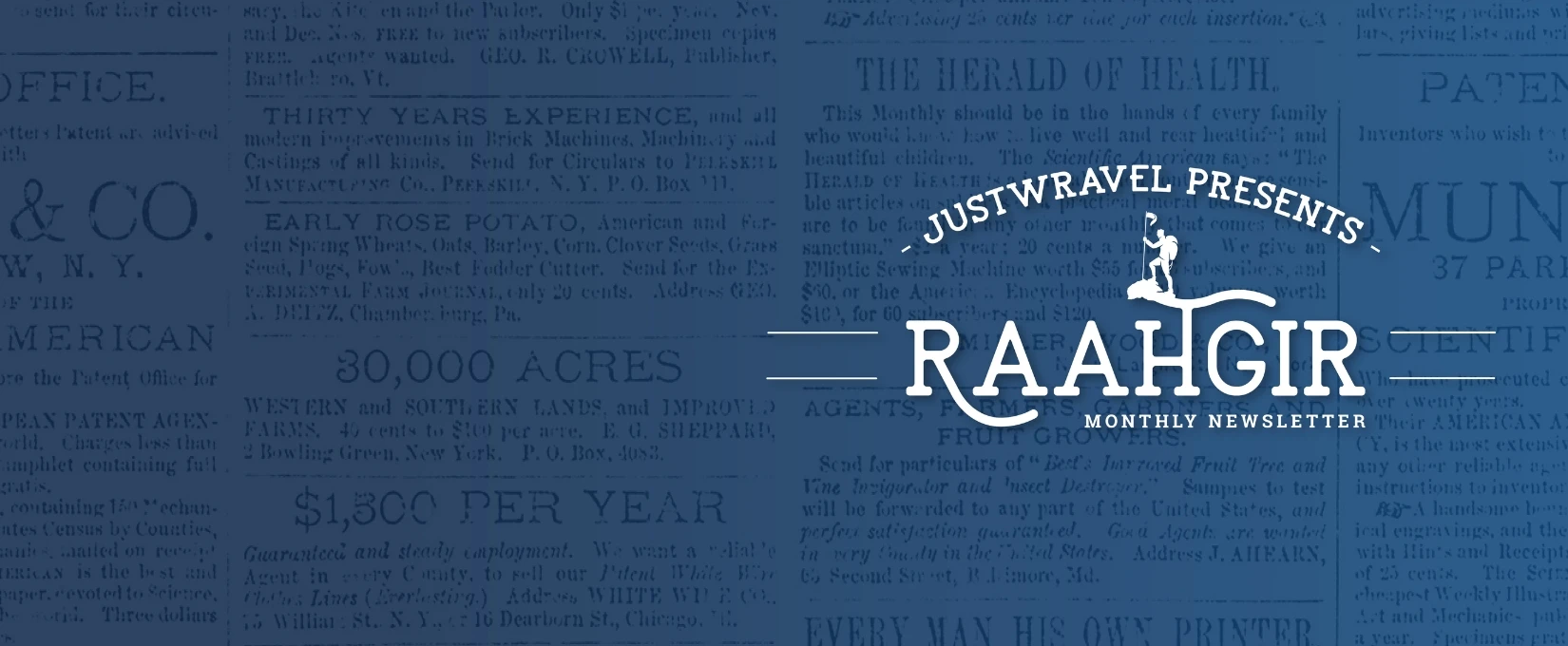
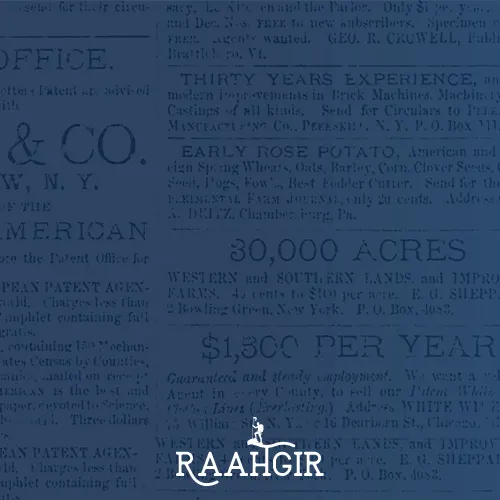
Newsletter
Sign up now!
Be the first one to know all about the Exciting Offers, Travel Updates and more.

B-42, 2nd Floor, Tower- B, The Corenthum, Block A, Sector 62, Noida, Uttar Pradesh 201301
© 2015-2025 JustWravel Pvt. Ltd.
Starts From
₹ 13,500

